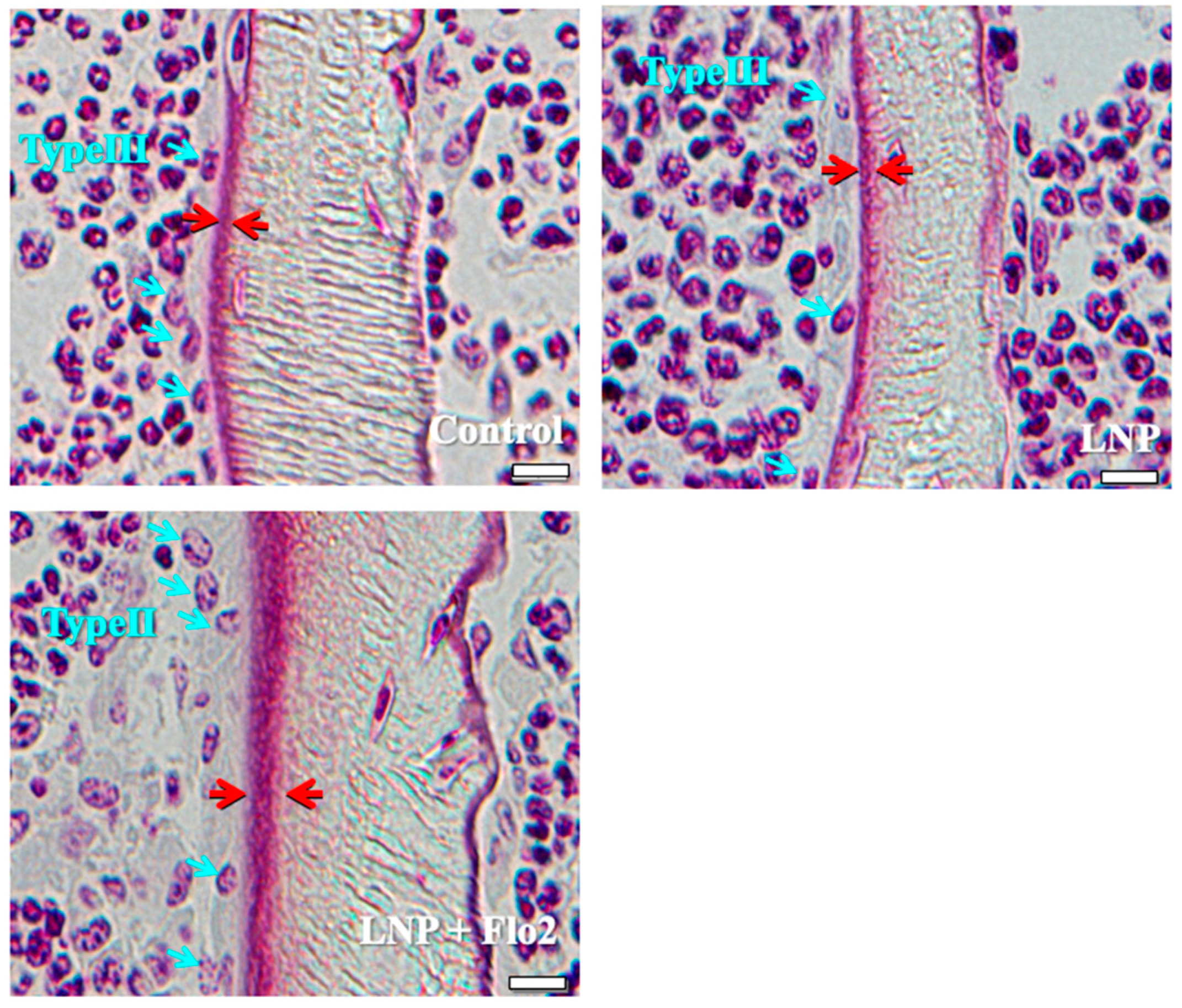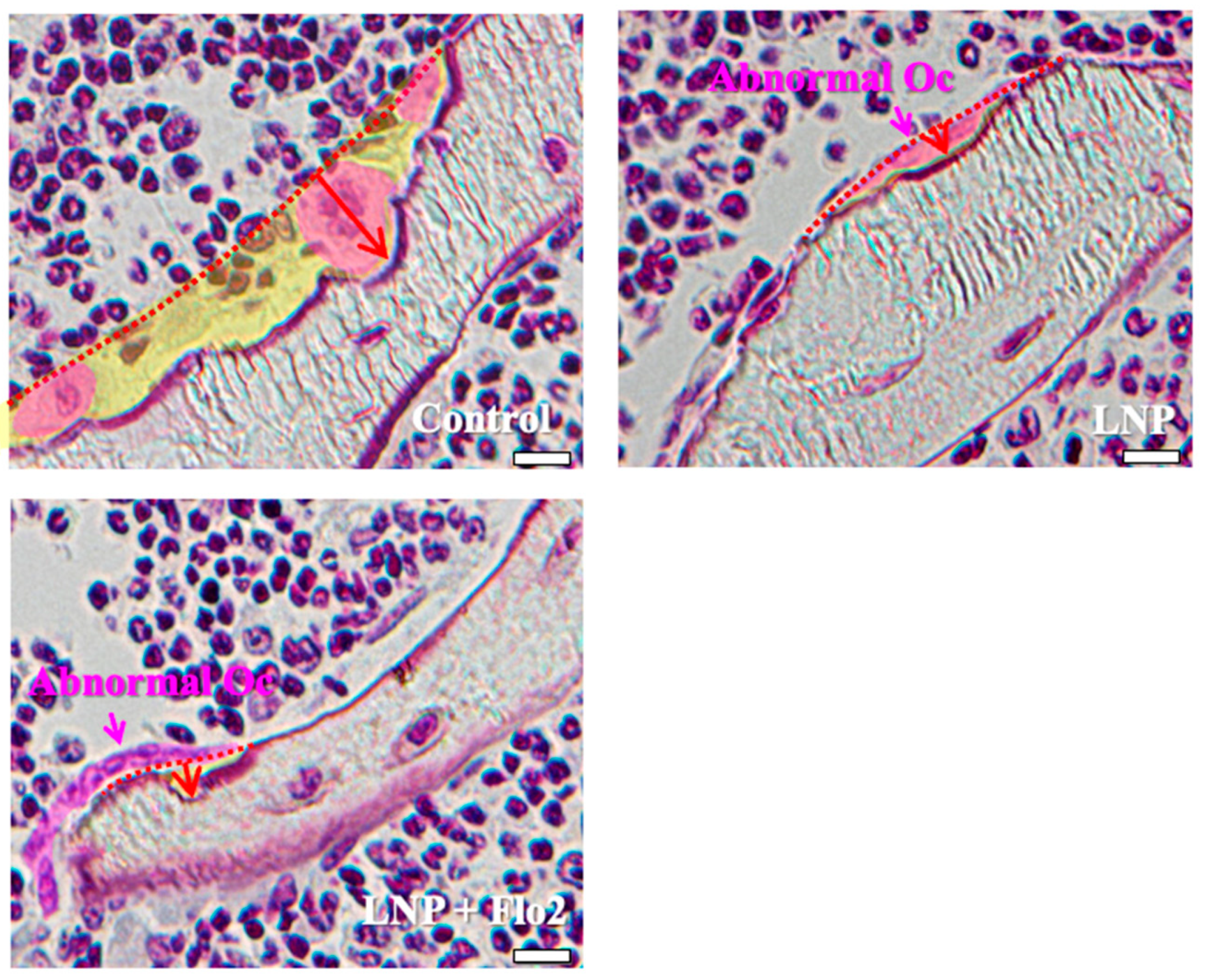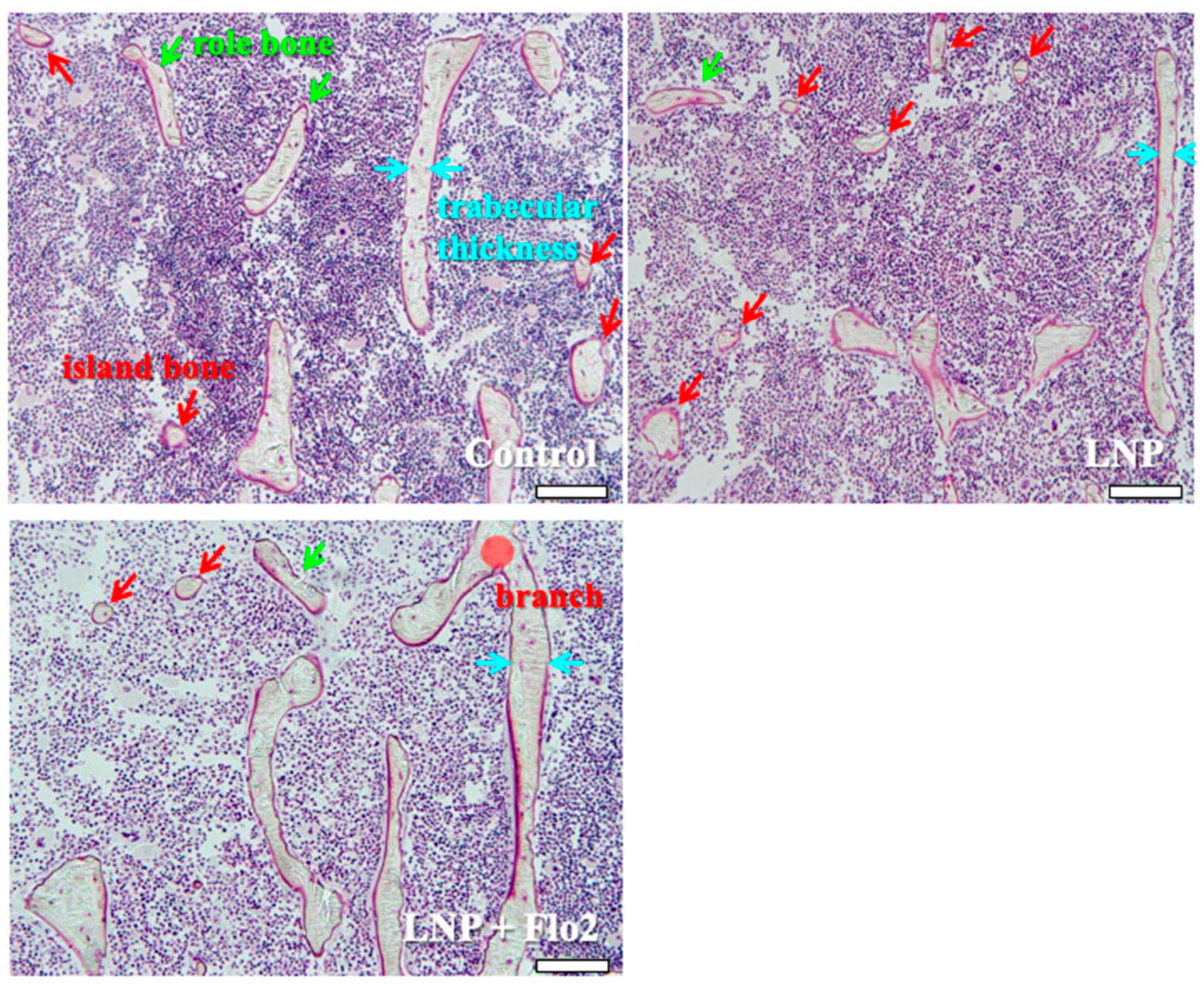Intra-Bone Marrow Administration of miR-140-3p Improves Bone Metabolism in a Growing Senescence-Accelerated Mouse Prone 6 Strain
Abstract
1. Introduction
2. Materials and Methods
2.1. Preparation of LNP Containing miR-140-3p
2.2. Animals and Experimental Protocol
2.3. Biochemical Markers and Bone Turnover Markers
2.4. Trabecular (Tb) BMD
2.5. Bone Histomorphometry
2.6. Immunofluorescence Staining of Insulin in Pancreatic Islets of Langerhans
2.7. Statistical Analysis
3. Results
3.1. Growth of SAMP6 and Influence of Intra-Bone Injection
3.2. Biochemical Markers of SAMP6
3.3. Bone Turnover Biochemical Markers and BMD of SAMP6
3.4. Primary Measurements of Trabecular Bone of SAMP6
3.5. Mineralizing Parameters of Trabecular Bone of SAMP6
3.6. Microscopic Observation of Secondary Spongiosa of SAMP6
3.7. Immunofluorescence Staining for Insulin in Pancreatic Islets of Langerhans
4. Discussion
5. Conclusions
6. Patents
Author Contributions
Funding
Institutional Review Board Statement
Informed Consent Statement
Data Availability Statement
Acknowledgments
Conflicts of Interest
Abbreviations
| ALP | alkaline phosphatase |
| ANOVA | analysis of variance |
| BMP | bone morphogenetic protein |
| BS | bone surface |
| BV | bone volume |
| Ca | calcium |
| CL | calcein |
| CTX | C-terminal telopeptides of type I collagen |
| dLS | double-labeled surface |
| ES | eroded surface |
| Flo2 | flotillin-2 |
| Gla | carboxylated osteocalcin |
| Glu | under-carboxylated osteocalcin |
| HbA1c | hemoglobin A1c |
| IP | inorganic phosphorus |
| LNP | lipid nanoparticle |
| miRNA | microRNA |
| MV | microvesicle |
| Obs | osteoblasts |
| OCN | osteocalcin |
| OCs | osteoclasts |
| SAMP6 | senescence-accelerated mice prone 6 strain |
| SD | standard deviation |
| Tb.Th | trabecular thickness |
| TL | tetracycline hydrochloride |
| TP | total protein |
| TRACP 5b | tartrate-resistant acid phosphatase-5b |
| TV | tissue volume |
| U-Ca | urinary calcium |
| U-Cre | urinary creatinine |
References
- Ishimi, Y. Osteoporosis and Lifestyle. J. Nutr. Sci. Vitaminol. 2015, 61, S139–S141. [Google Scholar] [PubMed]
- Capulli, M.; Paone, R.; Rucci, N. Osteoblast and osteocyte: Games without frontiers. Arch. Biochem. Biophys. 2014, 561, 3–12. [Google Scholar]
- Lin, C.; Jiang, X.; Dai, Z.; Guo, X.; Weng, T.; Wang, J.; Li, Y.; Feng, G.; Gao, X.; He, L. Sclerostin mediates bone response to mechanical unloading through antagonizing Wnt/beta-catenin signaling. J. Bone Min. Res. 2009, 24, 1651–1661. [Google Scholar] [CrossRef] [PubMed]
- Datta, H.K.; Ng, W.F.; Walker, J.A.; Tuck, S.P.; Varanasi, S.S. The cell biology of bone metabolism. J. Clin. Pathol. 2008, 61, 577–587. [Google Scholar]
- Nakashima, T.; Hayashi, M.; Fukunaga, T.; Kurata, K.; Oh-Hora, M.; Feng, J.Q.; Bonewald, L.F.; Kodama, T.; Wutz, A.; Wagner, E.F.; et al. Evidence for osteocyte regulation of bone homeostasis through RANKL expression. Nat. Med. 2011, 17, 1231–1234. [Google Scholar] [CrossRef] [PubMed]
- Cai, Y.; Yu, X.; Hu, S.; Yu, J. A brief review on the mechanisms of miRNA regulation. Genom. Proteom. Bioinform. 2009, 7, 147–154. [Google Scholar]
- Vimalraj, S.; Selvamurugan, N. MicroRNAs: Synthesis, Gene Regulation and Osteoblast Differentiation. Curr. Issues Mol. Biol. 2013, 15, 7–18. [Google Scholar] [CrossRef]
- Fushimi, S.; Nohno, T.; Nagatsuka, H.; Katsuyama, H. Involvement of miR-140-3p in Wnt3a and TGFbeta3 signaling pathways during osteoblast differentiation in MC3T3-E1 cells. Genes Cells 2018, 23, 517–527. [Google Scholar] [CrossRef]
- Takeda, T.; Hosokawa, M.; Takeshita, S.; Irino, M.; Higuchi, K.; Matsushita, T.; Tomita, Y.; Yasuhira, K.; Hamamoto, H.; Shimizu, K.; et al. A new murine model of accelerated senescence. Mech. Ageing Dev. 1981, 17, 183–194. [Google Scholar]
- Matsushita, M.; Tsuboyama, T.; Kasai, R.; Okumura, H.; Yamamuro, T.; Higuchi, K.; Kohno, A.; Yonezu, T.; Utani, A.; Umezawa, M.; et al. Age-related changes in bone mass in the senescence-accelerated mouse (SAM). SAM-R/3 and SAM-P/6 as a new murine models for senile osteoporosis. Am. J. Pathol. 1986, 125, 276–283. [Google Scholar]
- Ohnishi, K.; Tomimoto, H.; Akiguchi, I.; Seriu, N.; Kawamata, T.; Nakamura, S.; Kimura, J.; Nishio, T.; HIiguchi, K.; Hosokawa, M. Age-related decrease of nerve growth factor-like immunoreactivity in the basal forebrain of senescence-accelerated mice. Acta Neuropathol. 1995, 90, 11–16. [Google Scholar] [CrossRef] [PubMed]
- Takeda, T.; Hosokawa, M.; Higuchi, K. Senescence-accelerated mouse (SAM): A novel murine model of senescence. Exp. Gerontol. 1997, 32, 105–109. [Google Scholar] [CrossRef] [PubMed]
- Duque, G.; Macoritto, M.; Dion, N.; Ste-Marie, L.G.; Kremer, R. 1,25(OH)2D3 acts as a bone-forming agent in the hormone-independent senescence-accelerated mouse (SAM-P/6). Am. J. Physiol. Endocrinol. Metab. 2005, 288, E723–E730. [Google Scholar] [CrossRef]
- Katsuyama, H.; Fushimi, S.; Yamane, K.; Watanabe, Y.; Shimoya, K.; Okuyama, T.; Katsuyama, M.; Saijoh, K.; Tomita, M. Effect of vitamin K2 on the development of stress-induced osteopenia in a growing senescence-accelerated mouse prone 6 strain. Exp. Ther. Med. 2015, 10, 843–850. [Google Scholar] [CrossRef] [PubMed]
- Komori, T. Functions of Osteocalcin in Bone, Pancreas, Testis, and Muscle. Int. J. Mol. Sci. 2020, 21, 7513. [Google Scholar] [CrossRef]
- Mera, P.; Laue, K.; Wei, J.; Berger, J.M.; Karsenty, G. Osteocalcin is necessary and sufficient to maintain muscle mass in older mice. Mol. Metab. 2016, 5, 1042–1047. [Google Scholar] [CrossRef]
- Levinger, I.; Scott, D.; Nicholson, G.C.; Stuart, A.L.; Duque, G.; McCorquodale, T.; Herrmann, M.; Ebeling, P.R.; Sanders, K.M. Undercarboxylated osteocalcin, muscle strength and indices of bone health in older women. Bone 2014, 64, 8–12. [Google Scholar] [CrossRef]
- Moriishi, T.; Ozasa, R.; Ishimoto, T.; Nakano, T.; Hasegawa, T.; Miyazaki, T.; Liu, W.; Fukuyama, R.; Wang, Y.; Komori, H.; et al. Osteocalcin is necessary for the alignment of apatite crystallites, but not glucose metabolism, testosterone synthesis, or muscle mass. PLoS Genet. 2020, 16, e1008586. [Google Scholar] [CrossRef]
- Deng, L.; Wang, Y.; Peng, Y.; Wu, Y.; Ding, Y.; Jiang, Y.; Shen, Z.; Fu, Q. Osteoblast-derived microvesicles: A novel mechanism for communication between osteoblasts and osteoclasts. Bone 2015, 79, 37–42. [Google Scholar] [CrossRef]
- Takada, K.; Inaba, M.; Ichioka, N.; Ueda, Y.; Taira, M.; Baba, S.; Mizokami, T.; Wang, X.; Hisha, H.; Iida, H.; et al. Treatment of senile osteoporosis in SAMP6 mice by intra-bone marrow injection of allogeneic bone marrow cells. Stem Cells 2006, 24, 399–405. [Google Scholar] [CrossRef]
- Kazama, J.J.; Yamamoto, S.; Narita, I.; Kurihara, S. Nuclear chromatin-concentrated osteoblasts in renal bone diseases. Ther. Apher. Dial. 2011, 15 (Suppl. S1), 9–13. [Google Scholar] [CrossRef] [PubMed]
- Kawamori, Y.; Katayama, Y.; Asada, N.; Minagawa, K.; Sato, M.; Okamura, A.; Shimoyama, M.; Nakagawa, K.; Okano, T.; Tanimoto, M.; et al. Role for vitamin D receptor in the neuronal control of the hematopoietic stem cell niche. Blood 2010, 116, 5528–5535. [Google Scholar] [PubMed]
- Dempster, D.W.; Compston, J.E.; Drezner, M.K.; Glorieux, F.H.; Kanis, J.A.; Malluche, H.; Meunier, P.J.; Ott, S.M.; Recker, R.R.; Parfitt, A.M. Standardized nomenclature, symbols, and units for bone histomorphometry: A 2012 update of the report of the ASBMR Histomorphometry Nomenclature Committee. J. Bone Min. Res 2013, 28, 2–17. [Google Scholar]
- Kanda, Y. Investigation of the freely available easy-to-use software ‘EZR’ for medical statistics. Bone Marrow Transpl. 2013, 48, 452–458. [Google Scholar] [CrossRef]
- Washimi, Y.; Chen, H.; Ito, A.; Takao, R.; Uzawa, T.; Yamamoto, Y.; Yamada, H.; Shoumura, S. Effect of intermittent treatment with human Parathyroid Hormone 1-34 in SAMP6 senescence-accelerated mice. J. Endocrinol. Investig. 2010, 33, 395–400. [Google Scholar] [CrossRef]
- Jing, D.; Hao, J.; Shen, Y.; Tang, G.; Li, M.L.; Huang, S.H.; Zhao, Z.H. The role of microRNAs in bone remodeling. Int. J. Oral Sci. 2015, 7, 131–143. [Google Scholar]
- Xie, Y.; Chen, Y.; Zhang, L.; Ge, W.; Tang, P. The roles of bone-derived exosomes and exosomal microRNAs in regulating bone remodelling. J. Cell Mol. Med. 2017, 21, 1033–1041. [Google Scholar]
- Liu, Q.; Wu, T.; Zheng, H.; Chen, S.; Chen, Y.; Chen, L.; Lin, Z. MiR-140-3p overexpression activates the Wnt signaling pathway to promote fracture healing. Eur. J. Med. Pharmacol. Sci. 2019, 23, 6011–6017. [Google Scholar]
- Mizokami, A.; Kawakubo-Yasukochi, T.; Hirata, M. Osteocalcin and its endocrine functions. Biochem. Pharmacol. 2017, 132, 1–8. [Google Scholar]
- Otani, T.; Mizokami, A.; Hayashi, Y.; Gao, J.; Mori, Y.; Nakamura, S.; Takeuchi, H.; Hirata, M. Signaling pathway for adiponectin expression in adipocytes by osteocalcin. Cell Signal 2015, 27, 532–544. [Google Scholar]
- Williams, C.; Sapra, A. Biochemical Markers of Osteoporosis; StatPearls: Treasure Island, FL, USA, 2024. [Google Scholar]
- Kanazawa, I. Interaction between bone and glucose metabolism. Endocr. J. 2017, 64, 1043–1053. [Google Scholar] [PubMed]
- Li, Y.; Shrestha, A.; Zhang, H.; Li, L.; Li, D.; Fu, T.; Song, J.; Ji, P.; Huang, Y.; Chen, T. Impact of diabetes mellitus simulations on bone cell behavior through in vitro model. J. Bone Min. Metab. 2020, 38, 607–619. [Google Scholar] [CrossRef] [PubMed]
- Rosen, C.J.; Motyl, K.J. No bones about it: Insulin modulates skeletal remodeling. Cell 2010, 142, 198–200. [Google Scholar] [CrossRef] [PubMed][Green Version]






| Measurement | Control (n = 6) | LNP (n = 6) | LNP + Flo2 (n = 6) |
|---|---|---|---|
| Initial body weight (g) | 22.6 ± 2.0 | 23.4 ± 1.4 | 23.9 ± 1.5 |
| Final body weight (g) | 28.4 ± 2.1 | 30.2 ± 1.5 | 30.0 ± 1.1 |
| ALP (U/L) | 209.3 ± 13.3 | 218.2 ± 29.2 | 202.7 ± 16.1 |
| TP (mg/dL) | 5.10 ± 0.14 | 5.23 ± 0.15 | 4.98 ± 0.22 # |
| Ca (mg/dL) | 10.13 ± 0.10 | 10.15 ± 0.18 | 9.83 ± 0.23 * |
| IP (mg/dL) | 7.03 ± 1.10 | 8.63 ± 1.47 # | 7.23 ± 0.48 |
| Insulin (ng/mL) | 6.70 ± 4.42 | 5.76 ± 3.82 | 3.68 ± 1.18 |
| Glucose (mg/dL) | 186.0 ± 18.5 | 183.2 ± 27.6 | 193.5 ± 32.7 |
| HbA1c (%) | 3.87 ± 0.09 | 3.82 ± 0.04 | 3.81 ± 0.08 |
| U-Ca/U-Cre (mg/mg Cre) | 0.30 ± 0.13 | 0.38 ± 0.18 | 0.24 ± 0.04 |
| Measurement | Control (n = 6) | LNP (n = 6) | LNP + Flo2 (n = 6) |
|---|---|---|---|
| Glu (ng/mL) | 1.81 ± 0.41 | 1.73 ± 0.18 | 1.57 ± 0.23 |
| Gla (ng/mL) | 53.6 ± 7.6 | 63.2 ± 4.0 * | 64.1 ± 6.7 * |
| TRACP-5b (U/L) | 13.5 ± 1.2 | 14.3 ± 2.6 | 14.3 ± 1.4 |
| CTX (ng/mL Cre) | 5.21 ± 0.10 | 5.10 ± 0.67 | 5.38 ± 1.74 |
| Trabecular BMD (mg/cm3) | 293.9 ± 11.5 | 264.5 ± 36.2 | 295.3 ± 55.5 |
| Cortical BMD (mg/cm3) | 633.1 ± 21.4 | 649.4 ± 42.7 | 638.1 ± 26.2 |
| Measurement | Control | LNP | LNP + Flo2 |
|---|---|---|---|
| N.Ob.Type II/BS (N/mm) | 5.96 ± 3.25 | 7.66 ± 0.82 | 11.72 ± 3.85 *1 |
| N.Ob.Type III/BS (N/mm) | 5.62 ± 3.05 | 4.75 ± 1.35 | 5.42 ± 0.56 |
| N.Ob.Type IV/BS (N/mm) | 1.81 ± 1.18 | 1.44 ± 0.52 | 1.33 ± 0.55 |
| Tb.Th (μm) | 27.1 ± 2.6 | 26.2 ± 2.6 | 31.2 ± 2.8 *2 |
| O.Th (μm) | 2.21 ± 0.08 | 2.22 ± 0.05 | 3.00 ± 0.15 *3 |
| N.Mu.Oc/BS (N/mm) | 3.49 ± 0.57 | 2.89 ± 2.31 | 1.33 ± 0.87 *1 |
| N.Mo.Oc/BS (N/mm) | 1.04 ± 0.47 | 0.97 ± 0.50 | 0.39 ± 0.06 *3 |
| N.Abnormal Oc/BS (N/mm) | 0 | 1.83 ± 0.44 *4 | 2.01 ± 0.48 *1 |
| Erosion depth (μm) | 18.70 ± 1.66 | 15.52 ± 1.34 *4 | 16.53 ± 0.81 *1 |
| Parameter | Control | LNP | LNP + Flo2 |
|---|---|---|---|
| BV/TV (%) | 7.71 ± 1.36 | 7.49 ± 1/35 | 11.68 ± 1/94 *1 |
| ES/BS (%) | 39.9 ± 3.9 | 40.2 ± 7.1 | 32.3 ± 3.2 *1 |
| MAR (μm/D) | 2.58 ± 0.34 | 2.72 ± 0.28 | 3.10 ± 0.11 *1 |
| MS/BS (%) | 40.9 ± 2.7 | 38.8 ± 2.4 | 40.0 ± 2.5 |
| BFR/BS (mm3/mm2/year) | 0.38 ± 0.04 | 0.38 ± 0.04 | 0.45 ± 0.04 *1 |
| Ob.S/BS (%) | 17.8 ± 3.0 | 19.1 ± 2.0 | 26.0 ± 4.4 *1 |
| Oc.S/BS (%) | 11.2 ± 1.9 | 9.7 ± 7.5 | 4.7 ± 2.9 *2 |
Disclaimer/Publisher’s Note: The statements, opinions and data contained in all publications are solely those of the individual author(s) and contributor(s) and not of MDPI and/or the editor(s). MDPI and/or the editor(s) disclaim responsibility for any injury to people or property resulting from any ideas, methods, instructions or products referred to in the content. |
© 2025 by the authors. Licensee MDPI, Basel, Switzerland. This article is an open access article distributed under the terms and conditions of the Creative Commons Attribution (CC BY) license (https://creativecommons.org/licenses/by/4.0/).
Share and Cite
Katsuyama, H.; Tanda, K.; Terada, K.; Fushimi, S.; Yoda, T.; Katsuyama, V.; Nohno, T. Intra-Bone Marrow Administration of miR-140-3p Improves Bone Metabolism in a Growing Senescence-Accelerated Mouse Prone 6 Strain. Biomedicines 2025, 13, 883. https://doi.org/10.3390/biomedicines13040883
Katsuyama H, Tanda K, Terada K, Fushimi S, Yoda T, Katsuyama V, Nohno T. Intra-Bone Marrow Administration of miR-140-3p Improves Bone Metabolism in a Growing Senescence-Accelerated Mouse Prone 6 Strain. Biomedicines. 2025; 13(4):883. https://doi.org/10.3390/biomedicines13040883
Chicago/Turabian StyleKatsuyama, Hironobu, Kazue Tanda, Kumiko Terada, Shigeko Fushimi, Takeshi Yoda, Vitalii Katsuyama, and Tsutomu Nohno. 2025. "Intra-Bone Marrow Administration of miR-140-3p Improves Bone Metabolism in a Growing Senescence-Accelerated Mouse Prone 6 Strain" Biomedicines 13, no. 4: 883. https://doi.org/10.3390/biomedicines13040883
APA StyleKatsuyama, H., Tanda, K., Terada, K., Fushimi, S., Yoda, T., Katsuyama, V., & Nohno, T. (2025). Intra-Bone Marrow Administration of miR-140-3p Improves Bone Metabolism in a Growing Senescence-Accelerated Mouse Prone 6 Strain. Biomedicines, 13(4), 883. https://doi.org/10.3390/biomedicines13040883








